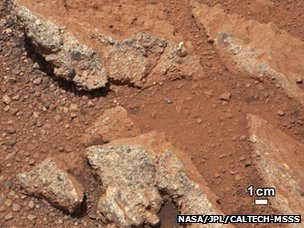Curiosity rover has only been on the surface of Mars seven weeks but it has already turned up evidence of past flowing water on the planet.
The robot has returned pictures of classic conglomerates – rocks that are made up of gravels and sand.
Scientists on the mission team say the size and rounded shape of the pebbles in the rock indicate they had been transported and eroded in water.
Researchers think the rover has found a network of ancient streams.
The rocks, which were described in a media briefing at NASA’s Jet Propulsion Laboratory in California, were likely laid down “several billion years ago”. But the actual streams themselves may have persisted on the surface for long periods, said Curiosity science co-investigator Bill Dietrich of the University of California, Berkeley.
“We would anticipate that it could easily be thousands to millions of years,” he told reporters.

Satellites at Mars have long captured images of channels on the planet’s surface that were cut by some kind of flow, assumed to be liquid water. Curiosity’s discovery at its landing site in the equatorial Gale Crater provides the first real ground truth for those observations.
By luck, the rover just happened to roll past a spectacular example of the conglomerate. A large slab, 10-15 cm thick, was lifted out of the ground at an angle.
“We’ve named it Hottah,” said rover project scientist John Grotzinger. The name refers to a lake in Canada’s Northwest Territories. The team is using names from this region to catalogue objects at Gale.
“To us it just looked like somebody came along the surface of Mars with a jackhammer and lifted up the sidewalk that you might see in downtown LA at a construction site,” he joked.
Scientists are now studying the images of the pebbles in the rock. The sizes and shapes will give them clues to the speed and distance of the ancient water flow.
The discovery site lies between the northern rim of the crater and the huge mountain that rises up from its central plain.
Previous orbital imagery of the region had hinted there might have been a water feature there. Curiosity’s conglomerates support that hypothesis.
The current interpretation is that the rover is sitting at the head of an alluvial fan of material that washed down through the crater wall and across the plain, cutting many individual streams. Researchers even think they can identify the particular valley at the rim where the water entered the crater, and they have named it Peace Vallis.
There is an eagerness also to study the chemistry of the conglomerates because that will give an indication of the nature of the water – its pH value, for example – and that will provide some clues as to what the environment at the time might have looked like.
At the moment, the rover is heading towards a location dubbed Glenelg. Scientists think this will give them the best access to the rocks of interest.
NASA’s $2.6 billion mission touched down on the Red Planet on 6 August (GMT).
Much of the time since then has been spent commissioning the immensely complex, six-wheeled machine and its suite of 10 instruments.
Curiosity is funded for one Martian year (two Earth years) of study. It will try to determine in that time whether past environments at Gale Crater could ever have supported microbial life.
